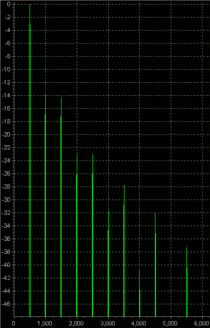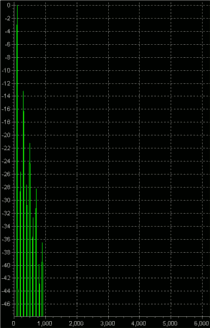Background
In 2006, through evaluation of a prototype distortion circuit featuring control over the amount of even order harmonics, it was concluded that a restrained amount of even order harmonics was preferred when playing low notes and chords due to decreased perceived muddiness and lower levels of unwanted intermodulation distortion. Larger amounts of even order harmonics were preferred in most other situations.
fig.2500Hz sine wave response

fig.1100Hz sine wave response
Concept
From the gathered information the supposition was made that in order to achieve the optimum of tone and playability, the amount of even order harmonics should increase with the input signal frequency.In conjunction with an emphasis on low order harmonics this would enable a full, vibrant tone while retaining a clear sounding low register and would furthermore promote string separation.
This concept was thus established as a design goal.
Whalestone Harmonics Generator
In 2009, the realization of the concept was finalized as the Whalestone Harmonics Generator and introduced in the Angelite overdrive/distortion pedal.The function can be studied by comparing spectrum analysis plots of Angelite responses from different input signal frequencies; the spectrum analysis plot of the Angelite response from a 100Hz sine wave (fig.1) reveals a smaller amount of even order harmonics than that from a 500Hz sine wave of equal amplitude (fig.2). The plots were made with all Angelite controls set at 12 o'clock.